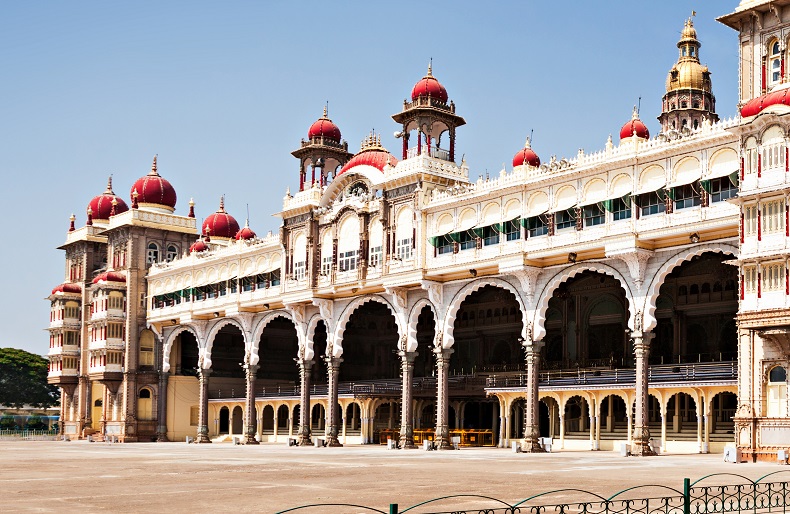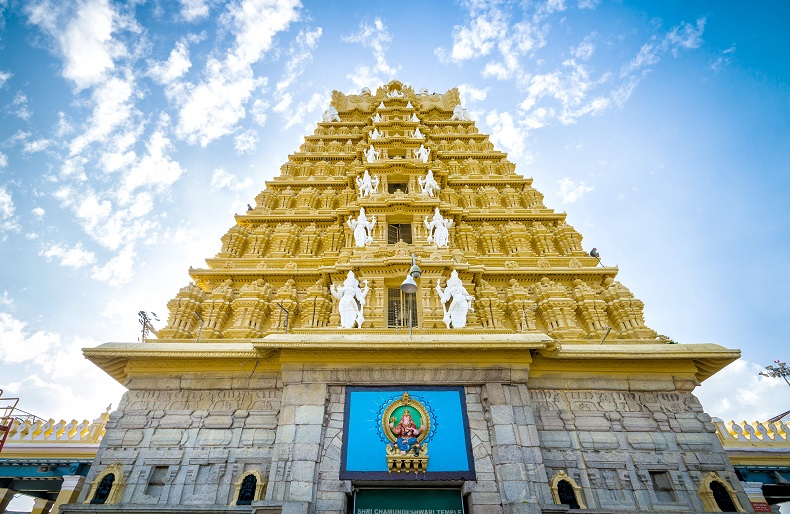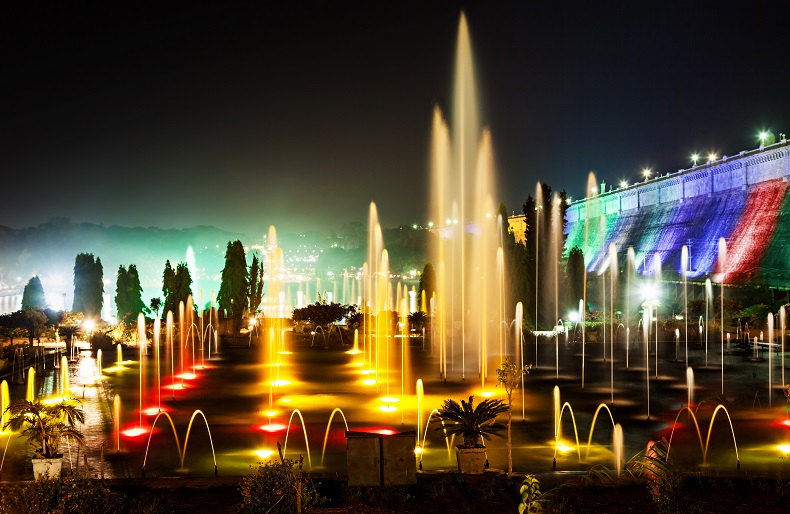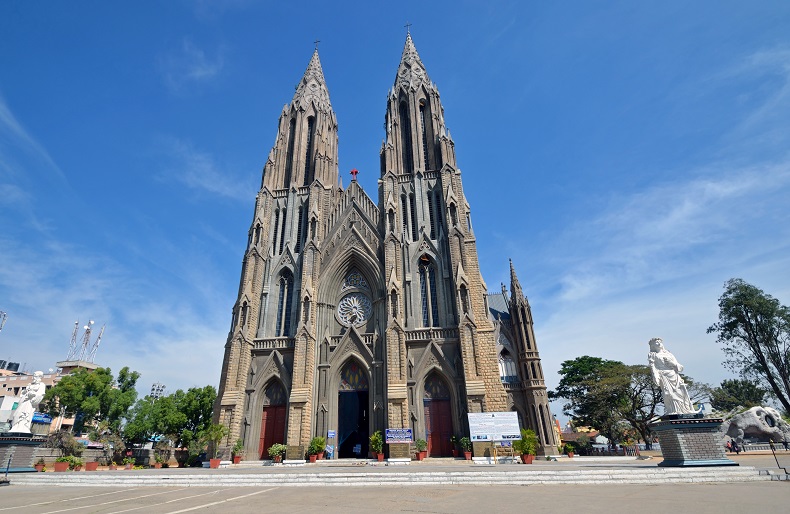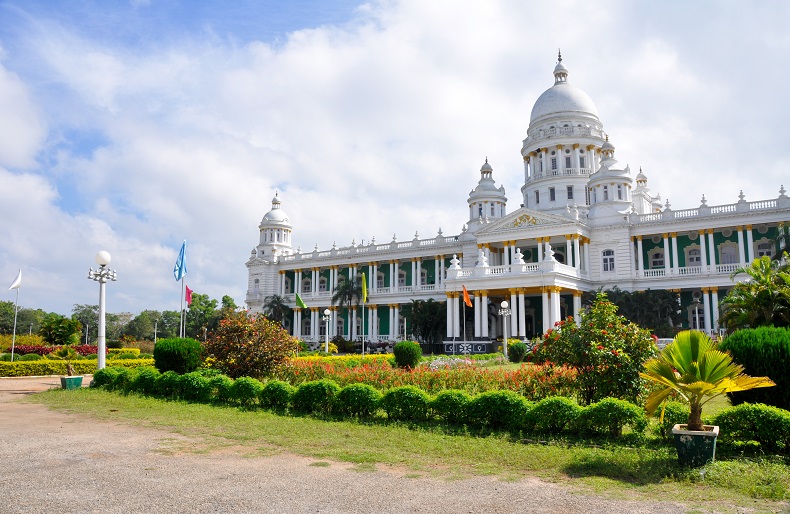Witness the royal heritage of the Mysore city
Mysore is a dream destination and a splendid blend of historical tradition, religious fervour and the modern vibrancy of a social set up. All this is supported by nature which is calm and serene inspiring every traveller to keep coming to this culturally rich terrain. We could go on incessantly about so many places to see and things to do in Mysore but we have highlighted only the most marvellous of the sites.
Splendour
The Amba Vilas Palace is a treasure trove of exquisite carvings from all over the world. The original wooden palace had burnt down and later in 1912 was rebuilt in its splendour by the British architect called Henry Irwin, during the reign of Maharaja Krishnaraja Wodiyar IV referred as “Rajarishi” by Mahatma Gandhi. Later it was further expanded by his son and the last Maharaja of Mysore, Maharaja Jayachamaraja Wodiyar. Having three entrances – East, South, and West but the main entrance is through the Gombe Thotti or the Doll’s Pavilion that has a vast collection of dolls that belong to the early 19th and 20th centuries. Here stands the grand wooden elephant Howdah which is adorned with 81 kg of gold. The seven canons that are situated in front of Gombe Thotti are used even today to mark the start and the closure of the Dussehra festival. The Marriage Hall adorned with chandeliers and stained Belgian glass ceiling set in peacock designs is frequently visited. The magnificent golden throne, studded with gems and made of 200 kgs of pure gold, is put on display during the Dussehra festival. The lovely paintings on the ceiling of the Durbar Hall are breathtakingly beautiful. The most spectacular and ornate room is the Diwan-i-khas and the places you could visit is the Portrait Gallery, the Royal Armoury, be awe-struck with the collection of costumes and jewellery, doors made of solid silver delicately carved, ornamental frescoes and stained glass ceilings with huge chandeliers. There are 12 temples in the Palace complex built in varied architectural styles between the 14th and 20th centuries. During Dussehra, the palace is illuminated with more than 96,000 lights.
Divinity
Having two options to reach the Chamundeshwari temple, located at 1000 ft. of the Chamundi temple; one can go by the steps or can drive through the interwoven valley road. Thousands of devotees visit this temple every year to pray to Goddess Durga and experience her fierce aura, the form of Shakti, a tutelary deity held in reverence for centuries by the Maharajas of Mysore. Goddess Durga’s idol is adorned daily and prayers are conducted by a number of priests. It also has statues of Nandi and Mahishasura, the demon. The Chamundeshwari Temple is considered as a Shakti Peetha and is one among the 18 Maha Shakti Peethas, offering an exhilarating view of the Mysore city. The way the temple is built and the fierceness of Goddess Durga inspires nothing but awe.
Nature
After divine interaction in the morning, in the evening you got to visit another sign of divinity, the gorgeous Brindavan Gardens with your family and friends. You will be enamoured by the greenery, the lush green lawns, the colourful blooms, the lovely fountains and take up the boat rides for a water adventure. Located at the foot of the Krishnaraja Sagar Dam, it was designed by Sir Mirza Ismail, the Diwan of Mysore, imitating the Mughal style of the Shalimar Gardens in Kashmir. If you happen to visit this piece of art after dusk you will witness the dance of the fountains, decked with colourful lights. At its south, there stood a palace which has now become a luxury hotel. If you travel a little further you can also see the beautiful Balmuri and the Edumuri Falls.
Brush with the wild
Having enjoyed the colours of nature, now it is time that you visit the animals in one of the oldest and largest zoos in the Southern parts of India. The Mysore zoo is also a highly organised zoo which was initially spread over 10 acres but later expanded to 250 acres. Designed by a German Landscaper, this Horticulturist was Mr. G.H. Krumbeigal, though the primary foundation was laid by Sri Chamarajendra Wodeyar in 1892. Initially it was known as Sri Chamarajendra Zoological Gardens. Famed for breeding some very rare animals in the zoo it has an exquisite collection of animals like lions, tigers, hyena, deer, elephants, rhinos, king cobras and birds; the showstoppers being the giraffes, jaguars, African elephants and the wallaby. Wildlife spotting is best in the early morning with a rush of the adrenalin quietened with a sense of quietude. The Karanji Lake forming a part of the zoo, boating facilities are also made available. s
The Blue Expanse
Going back to your Hotel can be done a little later because you need to absorb the stillness of the Karanji Lake right next to the Zoo. You will be enveloped in the silence of the surrounding, intermittently intervened by the bustle of the boat rides in the lake. Karanji Lake, often called the Fountain Lake has an immense fountain installed inside the lake. Covering an area of 90 acres it is home to more than 90 species of resident and migratory birds. It was originally constructed by the king of Mysore as a percolation tank to help the residents do their household chores, was later developed as a lake under the administration of the Mysore Zoo. An ideal location for family picnics, you can pack lunch and spend the whole day there. Asian openbill storks, cormorants, grey pelicans, are the main attractions. It also has India’s largest and first walkthrough aviary with a butterfly garden, created on a small island within the Karanji Lake housing at least 45 species of butterflies. Mind you, that you don’t plan to visit the Lake on Tuesdays as it is their weekly off. The captivating lake also consists of a Regional Museum of National history at its bank telling us about the natural environment of South India and how to ideally maintain it.
On the right track
Mysore’s Railway Museum is just adjacent to the Railway Station on the Krishnasagar Road. The museum showcases a superb assembly of various models of trains which have run in the history of Indian Railways. This exclusive collection comprises of engines which run on different gauges like narrow gauge, meter gauge, and broad gauge tracks, inspection coaches, vintage locomotive engines from different eras, steam cart, etc. A private train with two coaches used by the Maharaja of Mysore is put on exhibition in Sri Ranga Pavilion with an attachment of Maharani’s saloon carriage of 1899. The Pavilion also displays artefacts like different models of telephones, furniture, several photographs and memorable moments in the development of the Railways. A gallery by the name of Chamundi Gallery has great paintings related to the Indian Railways. Steam engines inclusive of the first steam engine and signalling accessories from the initial days of the railways in India are an interesting watch. It’s fun to ride the mini train operated by a battery which takes the visitors out for a joy ride on the museum grounds. Railway Museum is a must visit for children to learn about the Railway History and understand the science behind them.
The Saint’s Abode
One of the largest churches in the country, the St. Philomena’s Cathedral was built in 1956. Built in the dedication of St Philomena of the 3rd Century, Philomena was tortured and beheaded by the Roman King, Emperor Diocletian, since she refused to marry him and surrendered herself to God. She was later granted Sainthood. The Cathedral’s floor plan is in the form of a cross and has a crypt that houses a statue of St. Philomena, specially brought from France. Beneath the altar lies the relic of St. Philomena. Holding a strong resemblance to the Cologne Cathedral, the twin spires of the church are 175 feet in height and are quite similar to the spires of the St. Patrick’s Church in New York. Being Asia’s second largest Church, the main hall can seat up to 800 people and is decorated with stained glass depicting scenes from the life of Christ.
Royal gallery of art
Very close to the Mysore Palace, is a three-storied structure built in authentic Hindu style of architecture. External façade which had three entrances and a hall was added to the original palace. The interior walls are full of murals, depicting the Dussehra scene and the drawing of the sequence of the Jumbo Savari is spread across three walls. The Wodeyar’s lineage of the royal family is depicted by a family tree painted on a wall. The Dashavatara, the ten incarnations of the Lord Vishnu are also present in the palace. The palace, in 1915, was converted into an art gallery and was rechristened in 1955, as the Jagan Mohan Palace Art Gallery, after Sri Jayachamarajendra Wodeyar. This art gallery labelled as one of the best in South India contains paintings exceeding 2000 in number belonging to different Indian styles of painting like Mysore, Mughal, and Shantiniketan. It houses the prestigious collection of paintings of Raja Ravi Varma. Haldenkar’s ‘Lady with the Lamp’ is a solo exhibit in a dark room. Exhibits here also include weapons of war, musical instruments, sculptures, brass-ware, antique coins, and currencies. Some other unique artefacts exhibited here is a French clock which has a parade by miniature soldiers which showcase every hour; the sound of the bugle marks the minutes and the beating of the drums mark the seconds. Paintings made on a grain of rice which can be viewed only through a magnifying glass are also displayed here. Jagan Mohan palace has an auditorium used occasionally for cultural events.
Lalitha Mahal
This splendid massive palace, glistening in white was built to house the royal guests. It was designed by EW Fritchley from Mumbai in European & Indian styles. Beautifully designed, it is one of the most attractive palaces in South India. The lobby and corridors of the palace are sprinkled with beautiful paintings of Mysore rulers and historical events of the Mysore kingdom, like the siege of Srirangapatna Fort, the sons of Tipu etc. The staircase of the palace is exquisitely designed. The most attractive part of the palace is the restaurant block with its curved roof and the glass dome at the centre, with a large manicured garden. The palace now houses a five-star hotel and maintained by the Indian Tourist Development Corporation and is now utilized for local film shoots and various social gatherings.
Heartbeats for Talakedu
Devotees of Shiva make it a must to visit this unique destination. Located on the left bank of River Kaveri, Talakedu can be witnessed as a legacy of antiquity. It is reputed for its Vaidyanatheshwara temple dedicated to Lord Shiva. Two local Chieftains called Tala and Kadu give this place its name Talakadu. Several temples are located on the banks of River Kaveri that are buried in the sand and are taken out once in every 12 years for a special worship called the ‘Panchalinga Darshana’. The Panchalinga Darshana consist of five major temples namely Vaidyeshwara temple, Arkeshwara temple, Vasukishwara or Pataleshwara temple Saikateshwara or Maraleshwara temple and Mallikarjuna temple. It is said that the colour of the Pataleshwara Shivalinga changes with the time of the day, like red in the morning, black in afternoon and white in the evening.
Folklore on display
It’s unbelievable that a state’s folklore can be on display. The Folklore Museum is a unique collection of folk art, products, and articles, and its widespread showcase is mind-blowing.
Dakshina Kashi
Nanjangud is a town in Mysore better known as “Dakshina Kashi”, on the banks of the river Kapila. This city is also well known for a variety of bananas that are grown in the region. The Nanjangud temple, built in the Dravidian style in 300-1000 CE, houses three main deities, Lord Nanjundeshwara, Goddess Parvathi and Lord Vishnu with Sridevi and Bhudevi. During the Chariot Festival, shivalingas, mantapas, and other idols are taken out in a procession. When Tipu Sultan’s elephants got cured through the prayers offered to the deity. From that day, the deity is considered as a healer among the worshippers and the devotees take a holy dip in the Kapila River after the rituals.
Bonsai Garden-Small is beautiful
The Bonsai Garden of Mysore is home to over a 100 different varieties of Bonsai trees and this estate is a part of the Avadoota Datta Peetham of the Sri Ganapathi Sachidananda Ashrama. It started as a pet project of the Swamiji but eventually spread to 4 acres with 450 dwarf trees. The stream that flows within, makes it even more beautiful dotted with Buddha statues and monkey statues around the area, to highlight the Zen culture from where the art of Bonsai was evolved. There is also a deer park to cater to the nature lovers who visit. This garden represents the Indian zodiac system, Indian classical music, 27 stars of traditional Indian astrology, the Saptarishi, and five plant gardens closely linked with the concept of the Mother Goddess. The garden is indeed a delight to walk through due to the fine art and effort took to shape a 100-year-old tree within a lovely terracotta pot. Bonsai conventions are held here and experts from different parts of the world conduct workshops.
Chirpy parrots
The Shuka Vana in Mysore is a sure visit site for bird watchers, nesting about 2000 birds of over 450 varied species. This aviary is 50m high aviary spread over an acre of land currently holding the record for most bird species in an aviary in the Guinness Book of World Records. This exclusive Park is called the Parrot Park, and is a section of the Avadhoota Datta Peetham in the Sri Ganapathi Sachidananda Ashram, and also serves as a rehabilitation centre for injured and abandoned birds. You would find many rare species of parrots flying around this beautiful enclosure. Parrots here have allotted zodiac signs and you can find a parrot that represents birth dates and the respective planets as per Indian astrology. These birds also symbolise days and months of the year. These delightful creatures are considered instruments to invisible spirit dimensions.
In spite of stepping into modern development, Mysore has not let go of its history. The royal touch is still quite apparent in its environment with the religious significance of the city, remaining intact which is evident in its name Mysore, which comes from “Mahishur” which means the home of Mahishasura.
One of the best holidaying choices which has something interesting for everyone!

